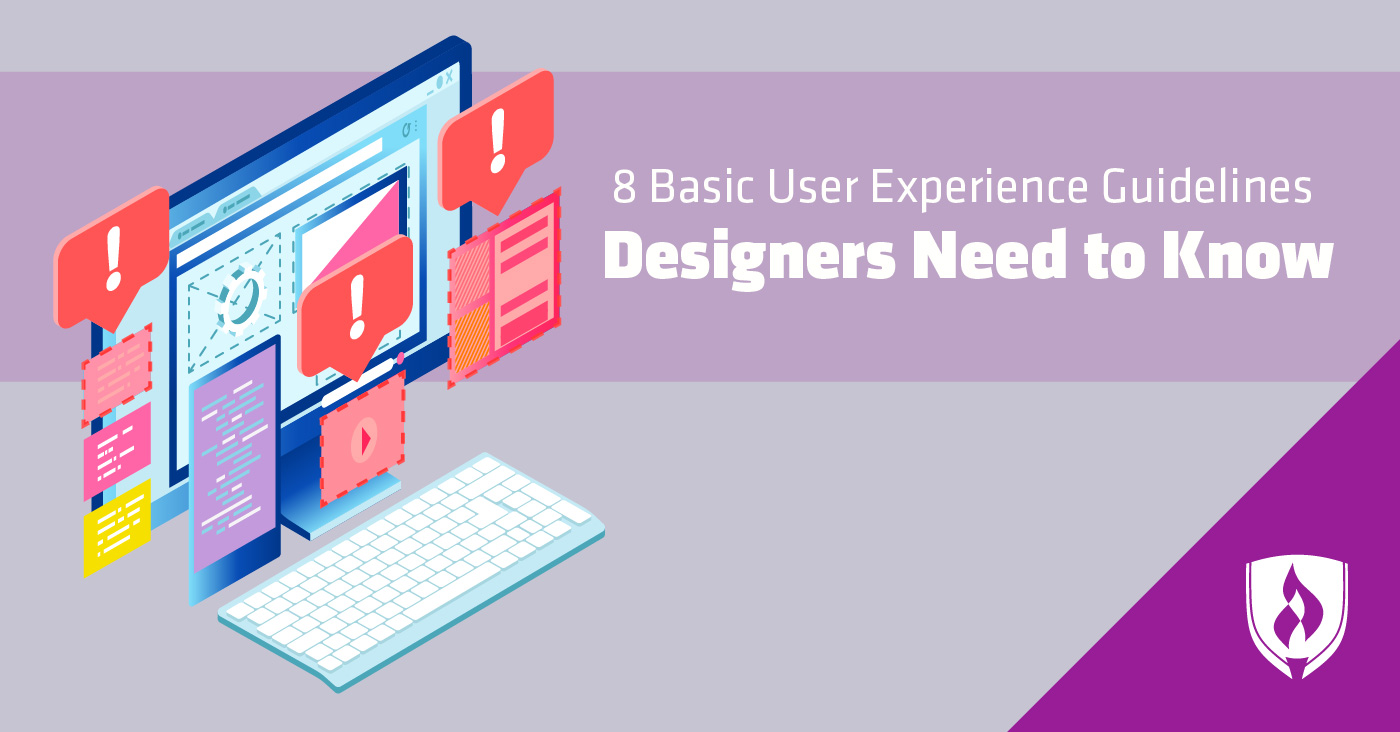
The promise of a creative career is what drew you to the design field. Now you can’t wait to begin executing your out-of-the-box ideas in a new design position! But before you take your vision to the drawing board, it’s important to keep some basic user experience guidelines in mind.
User experience (or UX for short) is the way an end user experiences a piece of design, whether that’s as a digital design for a website or app, or a print design like a billboard or brochure. UX guidelines ensure that a design is easy for a user to understand and interact with.
“Every piece of design has a user, whether it be an application or a building,” says Joey Dudgeon, lead designer at Insight Consultancy. “Understanding the user’s requirements and expectations is vital in success of a project.”
The end user’s experience is something that every designer needs to consider when they work on a project. We rounded up eight basic UX guidelines for you to follow as you bring your creative visions to life.
8 Basic UX guidelines to keep in mind
The purpose of design is to communicate a message to an audience, and these UX guidelines can help you share your message even more clearly. Take a look at these expert insights on UX principles so you can create designs that stand out from the crowd!
1. Know your audience
Big surprise, but it’s really difficult to create a design catered to a specific end user if you don’t know who the end user is. “Good UX designers should understand the user by creating a user persona,” Dudgeon says.
User personas include descriptions that help designers get to know the person they’re designing for. Along with basic demographic information, user personas will often include a user’s goals and a problem they need solving. Keep your user persona handy while working on a project so that their experience is always at the forefront of your mind.
And if you’re working for a client who hasn’t given it much thought? Ask! Even a halfway fleshed-out persona can help guide your design decisions—not to mention this effort shows you’re putting some real thought into your work.
2. Solve a problem for the user
Usability.gov lists “usefulness” as one of the keys of a good user experience, saying that content should “fulfill a need.” Strong UX-oriented designs don’t exist just to fill space. They need a purpose, which is usually solving a problem for the end user.
Designers who understand their user persona are in a good position to solve a problem through their project. “By understanding what the user’s pain points are, you can design your product around solving a problem for the user and therefore deliver value to them,” Dudgeon says.
3. Simple is better than complex
It can be tempting to add all sorts of bells and whistles to make your design go the extra mile. Unfortunately, too many extras can backfire, making your design complicated and difficult to navigate.
“Don’t reinvent the wheel,” Dudgeon says. “It may be more effective to use an existing design convention that your users will immediately understand.” Have some fun with your creative vision, but know when it’s time to rein it in to preserve a good user experience.
4. Group like items together
A psychology theory called the Gestalt Principles emerged in the 1920s to explain how people view objects and recognize patterns. Though they were described nearly 100 years ago, these principles still come into play on a daily basis for designers.
The Gestalt Principles form the foundation of many user experience best practices, including strategies for grouping objects in a way that helps viewers make connections and draw conclusions about the message being communicated. These timeless principles are much more than a passing design trend, and it’s worth brushing up on the basics to incorporate them into your designs.
5. Be accessible to all users
UX design needs to be user friendly to everyone, including people with disabilities. Accessibility is an important part of UX design, so much so that certain standards are mandated by the Americans with Disabilities Act (ADA).
Web designs in particular need to take accessibility into account. “Color contrast is often overlooked in design, but that can make life really difficult for colorblind users,” says Sam Orchard, creative director at Edge of the Web. “I often view the site in greyscale so that I can see whether text has sufficient contrast and make sure it’s still readable.”
6. Consider mobile design
As smartphones and tablets have continued to grow in popularity, the habits of internet users have shifted drastically. The previous default of designing for a desktop display isn’t long for this world—and many would say it’s time has already come. Despite this, many website designs still aren’t mobile friendly, resulting in a bad user experience for millions of people.
Every designer who works on apps or websites should have mobile users in mind as they craft a good user experience. “A common issue is making buttons look clickable,” Orchard says. You might take this for granted when using a computer, where you can hover your cursor over a link or button to see if it’s clickable. But mobile users don’t have that option. “Give your users a visual clue to guide them in the right direction,” Orchard says.
7. Make relevant information easy to find
Part of having a good user experience includes being “useful and usable,” with “findable” information, according to Usability.gov. In other words, don’t make people hunt for the information they need!
On the web, this means having an intuitive visual hierarchy that helps users navigate the site without taking detours to the wrong page as they search for what they need. In print design, be sure to make important information easy to read at a glance, like a phone number on a business card or the time and location on an event poster.
8. View your work with fresh eyes
This is the UX guideline that brings all the other best practices together. Designers who have put hours into a project may lose the ability to objectively “see” their work, overlooking barriers to the user experience that need to be fixed.
Designers in every industry need to take the occasional break from their work to gain a new perspective and approach the design like the end user would. “You always need to be able to look at the website as though it’s the first time you’ve seen it,” Orchard says.
Experience more of the design field
Now you know the basics of UX design, thanks to these user experience guidelines. Find out what other skills you need to launch a career in this creative field with our article, “8 Cutting-Edge Graphic Design Skills Employers Are Seeking in 2019 and Beyond.”
Related Articles:




